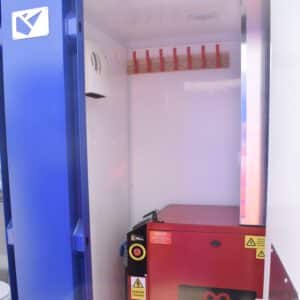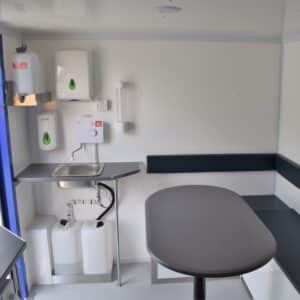Our Site Welfare Checklist
Our Site Welfare Checklist
12 August 2022
Here’s a quick guide to construction site welfare facilities that the Health and Safety Executive says must be provided.
It’s certainly not a comprehensive list of everything a good employer could do to ensure the wellbeing of their workforce – the HSE itself stresses that these are just minimum requirements. In fact, all of Enable Welfare’s mobile welfare vans and static welfare units not only meet all the HSE on-site welfare standards, but go well beyond them.
Nevertheless, we would suggest it’s well worth running through this quick checklist before you make your final decision on site welfare hire, portable loos for hire, and the like – just to make sure you are complying with the law.
Installing and removing from site
The HSE requirement: “You need to plan how welfare units will be moved from delivery vehicles into position. It is preferable to mechanically move these units; if manual handling cannot be avoided then you should manage the risk effectively.”
Enable Welfare’s mobile welfare vans are naturally easy to bring to site and quick to have up and running. All our static welfare cabins are lightweight, towable units, which makes their installation relatively simple, too. For ultimate peace of mind, we offer a full site set-up service for welfare cabins, which includes pre-delivery quality and safety inspections. All our lorries meet the FORS* Standard and are crewed by experienced operators. If required, our sister company Enable Hire can arrange a ‘contract lift’, undertaking crane lifting operations and assuming all responsibility for safety.
Toilets
The HSE requirement: “So far as is reasonably practicable you need to provide flushing toilets and running water, connected to mains water and drainage systems. If this is not possible, facilities with a built-in water supply and drainage tanks should be used. Portable chemical toilets are acceptable only if it is not reasonably practicable to make other adequate provision. BS6465–1:2006 recommends a ratio of 1 toilet to 7 persons where portable toilets are emptied once a week.”
Enable Welfare static welfare units come with either fully-flushing toilets or high-specification chemical toilets, depending on the model chosen. The toilet cubicle in our welfare vans features an electric flush and cassette waste disposal. Our freshwater flushing portable toilet cabins can be attached to mains water and sewerage, where available, but they also have their own waste tank, so can be made self-sufficient if you hire one of our water bowsers.
Washing facilities
The HSE requirement: Construction sites must be provided with “washing facilities next to both toilets and changing areas”. As well as soap, towels/dryers and sufficient lighting and ventilation, the washing facilities should include “a supply of clean hot and cold, or warm, water (which should be running water so far as is reasonably practicable)” and “sinks large enough to wash face, hands and forearms”.
All our static welfare units and welfare vans come with hot and cold water forearm sinks in both the toilet and canteen/changing areas. Towel and soap dispensers are also provided.
Drinking water
The HSE requirement: “A supply of wholesome drinking water should be readily available.”
Our static cabins have a 25-litre drinking water container. Enable Welfare’s range of welfare vans all come with an electric hot water facility for drinks.
Changing rooms and lockers
The HSE requirement: “Every site should have arrangements for securely storing personal clothing not worn on site and for protective clothing needed for site work. Provision should be made to allow wet clothing to be dried. As a general rule, clothing should not be placed directly on heaters due to the risk of fire.”
Enable Welfare static cabins all have generous amounts (up to 800 litres) of under-seat storage available, as well as individual personal storage compartments. They are equipped with a dedicated drying room fitted with coat hooks and a tubular heater. Our welfare vans are securely lockable and have a wet clothes storage area and drying room.

Rest facilities
The HSE requirement: “Rest facilities should provide shelter from wind and rain. The rest facilities should have adequate numbers of tables, seating with backs, a means for heating water for drinks and for warming up food (eg a gas or electrical heating ring or microwave oven) and be adequately heated.”
We can vouch for the fact that all our welfare units – vans and static cabins – are definitely weathertight and a comfortable place to take a break! Seating in the vans is with crash-tested M1 seats, while the canteen area in the static units has benches with backs positioned around rounded tables. The vans come with electric hot-water heaters; the static units are supplied with kettles. A microwave oven is standard for both.

Heating
The HSE requirement: “Rest facilities will normally require heating. Using properly maintained electrical equipment can eliminate the risks associated with LPG heaters.”
Our welfare vans have independent central heating, while the static welfare units have low-level plinth heaters in the main canteen space, as well as the tubular heater in the drying room/generator area. Insulation also helps keep them cosy even on the coldest days. Enable Welfare’s vans and static cabins do not use LPG heaters.